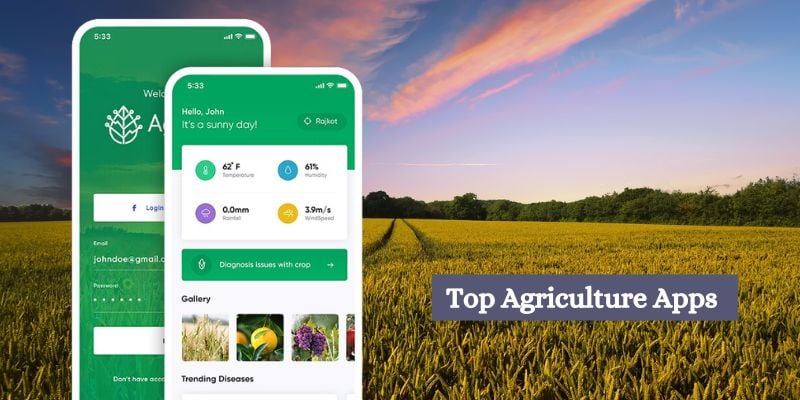In the current era, the agriculture sector is struggling through a lot of challenges. However, as we observe technological advancement over time, the industry responsible for feeding the world is expected to progress, too. Top agriculture apps are running in the market that are the most reliable today as these solutions offer much more than desired. A primary reason for designing smartphone apps for agriculture purposes is to guide farmers in regulating their farming methods using technologies. Not only do these apps fulfil the daily requirements, but they also assist them with the latest equipment.
Ever since technology entered the area of agriculture, we have observed different changes, from purchasing seeds from online stores to putting fertilisers throughout the farm via a drone. Agtech apps have diverse features, and one of the highlighted ones is e-shopping. Significant reasons state how mobiles percolated into farming and agriculture. Farmers previously travelled to farther places, even cities like theirs, to search for the best quality goods to buy the required products. But now, all the farming essentials can be ordered virtually through the app and delivered directly to the farms. The apps help connect farmers to the users so that both are benefitted without paying additional costs to third-party operators. Any app development company would provide IoT support to its consumers as it guides in automated irrigation crop fertilisation through drones and other activities, reducing the manual labour. The goods available in the online store’s stock have prices mentioned against them along with details, and the farmers are also notified about the availability/unavailability of products.
10 Best Agriculture Apps
1. Bushel Farm
Bushel Farm, formerly known as FarmLogs, provides an in-depth and thorough understanding of their farm's financial and operational performance. In contrast with managing multiple notebooks and spreadsheets, the app is counted amongst the best agriculture apps. It centralises the record array, consisting of scouting notes, gadgets, grain sales, inventories, work orders, field maps, land agreements, etc. The app has a strong automation feature that can transform the records into insightful observations that farmers employ to perform decision-making or share them with agronomists, bankers, grain buyers, or farm partners. The apprehension includes: production costs, profits gained from the sale of grains, profit marketing position, and gains and losses at the crop, field, or farm level.
Key features:
-
Farmers can sign e-documents from their mobiles.
-
Give real-time access to tickets that can be easily tracked.
-
Farmers can track the stock products, including fertilisers, pesticides, etc.
-
Market costs of grains, livestock, feed, and ethanol can be detected.
-
Farmers can forecast revenue by putting in settlement details.
2. AgriSync
AgriSync allows advisors and farmers to interact and work on the issues related to the farm. The agronomist can establish a connection with different advisors from multiple enterprises to give and take support through real-time video experience. Regulating numerous service tickets via remote video and dashboard allows one to analyse what can be seen in a real-time environment. As one of the top agriculture apps, it serves as a web-based platform that helps the advisor’s firm view open cases, farmer reviews, and resolution status. Farmers can utilise the standard service free of cost. After a few free trials, the users need to sign up for a subscription as a person or business.
Key features:
-
No data sharing with third parties is enabled.
-
Real-time connection is established to solve issues.
-
Allows making requests to gain support.
-
A unique network can be built altogether with trusted agronomists and advisors.
3. Agmatix
Agmatix assists farmers, researchers, and potential stakeholders in detangling complicated data directly from the field. One can simply join, design, and tackle their trials through the app. Things can be done at a rapid pace by framing checklists and regulations, assigning activities, gathering data, and observing outcomes without interruptions, irrespective of whether you are present on the field or not. It is one of the agriculture apps that offers a special Agronomic Trial Management SaaS solution to operate trials with transparency in data gathering on the field. If you join the app as a farmer, you can enjoy different advantages, such as planning, running, and visualising outputs.
Key features:
-
Instantly view the trial layout on the map.
-
View information on crops and locations on a single platform.
-
Recording information about fieldwork and treatments quickly.
-
Notes can be input with geolocation.
-
Enable professional management of project needs and staff permissions.
4. Agrology
Agrology, one of the leading agriculture apps, works with a fire map that allows farmers to keep a check on active fires in a range of 20-mile radius, despite any location on the earth. The Agrology app has enabled the fire map feature to be free for all users to gain insights into real-time workable information. The map delivers information in 3D form, allowing users to view the location closely by zooming in, allowing consumers to locate three locations at a time. The fire map is free of cost, which is a benefit as the users can be prepared for fire situations by getting a subscription to the Agrology Sentinel Climate Monitoring System.
Key features:
-
It represents data in an easy-to-read and understandable format.
-
Comprehensively tracks carbon projects, climate events, smoke taint, water, pests, disease, and irrigation.
-
It helps in the continuous monitoring and quantification of soil carbon flux and the composition of soil particles.
-
Enables a user to subscribe to plans on a monthly basis.
5. GSI Connect
GSI Connect leverages the quality of dried grains and connects users with the whole grain system. The initial capacity of the app keeps customers at peace by giving them insights into the performance of their dryer in real-time. You can observe the status of your dryer, moisture content, and degree of temperature and adjust them accordingly. Modify the dryer or stop it to estimate performance data directly through the application. The app notifies a user about errors to lower downtime and increase profit. To reduce the chance of encountering risks, enhance the consistency of the dryer, and cut off extra costs, GSI helps empower the operator to make rapid decisions to safeguard the crops.
Key features:
-
Quick access to dryers.
-
Set points can be adjusted along with load and fan settings and temperature and moisture regulation.
-
It can track the performance and efficiency of the dryer.
6. AgriBus-NAVI
Being a GNSS/GPS navigation application, AgriBus is considered one of the top agriculture apps, preventing farmers across the globe from spending extra money on crop treatment. The app comes into operation once the device is mounted on a vehicle/machinery or a tractor with the help of a mounting holder. When the user drives and checks the screen simultaneously, farming activities can be done in a line and in small intervals. The farmer can regulate the spray of fertilisers, improving the effectiveness of the farming process. Using an external GPS system, like GARMIN, is known to produce more accurate results in terms of position. Both a free and premium version of the app are offered. The paid version offers a wide range of additional functionalities, such as curve navigation, exported saved data, work history management, cloud service use, and knowing different factors like inclination, number of satellites, altitude difference, etc.
Key features:
-
Fundamental functions require no subscription and can be used readily.
-
Seamless navigation and trajectory display.
-
Work can also be tracked through the screen at night in case of poor visibility.
-
The number of users who get access is not limited.
-
Doesn’t require an internet connection.
-
If an external GPS is installed on the system, definite and precise results are received in centimetres.
7. FarmRise
The FarmRise app is available in many regional languages. In comparison to other top agriculture apps, it is the only one where farmers can understand crop practices via listening in their preferred language. The ranchers can get precise and particular advice for eco-friendly and profit-oriented farming. The app calculates temperature, rainfall certainty, and the level of humidity and gives updates to the farmers. This allows them to make informed decisions with regard to bowing seeds and reaping existing crops. The app operates independently and is not affiliated with any governmental organization.
Key features:
-
The app allows access to rainfall and temperature-related information every hour.
-
Users can read articles posted by Farm Rise experts on the app.
-
You can stay updated with region-specific news regularly on farming dynamics and learn in detail about the trade shows held countrywide.
-
Farmers can edit their existing location anytime.
8. iAgri
iAgri is a team of professional designers, developers, farmers, and marketers who wish to work with emerging innovations to thrive the process of farming overall. The team works in collaboration to develop an ultimate solution that stands out from other agriculture apps. It is simple to navigate and specially designed with the requirements of all types of clients kept in mind. It allows farming in a cost-effective manner, realizing financial capacities. Due to this, it integrates features such as budgeting and tracking. The app uses ML algorithms to help in forecasting growth, giving appropriate results regarding estimations. It uniquely addresses factors like sustainability and the environment and reports them.
Key features:
-
Assists in animal management activities, such as stock rotations, drugs and treatment, instrument integrations, feed budgeting, health and activities, etc.
-
Helps draw paddocks using satellite maps and adds threats, shelterbelts, and tracks the maps.
-
Keeping track of the staff, creating accounts for different workers, and enabling them to track different activities on the farm.
-
Helps assign tasks, links them to old locations and assets, and automates the updating of employee timesheets.
9. CropX
CropX is a user-friendly system that links agricultural data in real-time while giving farming suggestions throughout the process of managing overall data in one place for convenient sharing and tracking. When a user installs the app, they can interact with the soil sensors, telemetry gateways, and other monitoring gadgets. All work together to analyse the water and soil conditions with high accuracy. The recommendation feature passes time-to-time alerts to boost profits, save money on inputs, and record the concerned activities and relevant information. Farmers can gain deep insights into nutrient leaching, salinity, and temperature of the soil before planning on growing a crop, determining diseases and potential treatment sprays, and determining the progress of crops. The post-growing activities include the management of lagoon manure, climate outlooks, data on farm machines, ET, and rainfall data.
Key features:
-
Create farm records or data reports and share them when required.
-
Sensors of soil, satellites, and data sources empower the process of predicting agronomic situations.
-
The field map displays the water levels of the field.
-
Profile summary helps to know about water levels in past and future using graphics.
-
It also suggests how often crops should be irrigated and tracks the irrigation events throughout the season.
10. Climate FieldView
Climate FieldView is an online agriculture tool that provides archers with a panoramic suite of tools, allowing them to get deeply acquainted with their fields so they can determine the operation decisions for yield optimization, amplifying efficiency, and eliminating risks or hazards. The app is a leading digital platform assisting customers in gathering data and making sure to store it systematically and smoothly. The data is then monitored extensively, and the impact of agronomic settlements is measured according to crop performance. Field variability is managed by creating a separate personalised seeding plan for every field.
Key features:
-
Gather and save vital field data with ease.
-
Track and quantify how your agronomic choices affect crop production.
-
For optimal output and profit, manage the variety of your fields by creating tailored fertility and seeding programs for each one.
Must-Have Features in Agtech apps
There are top agriculture apps in the market that have expanded to a significant level. Agriculture app development has supported agronomists, and businesses are booming with handsome production rates to step into a broad market.
GPS Tracking
It is easier to conceive a farming app with location-based services. Ranchers might use maps to access different locations through various capabilities, like drone investigations and observing regional climate forecasts. This feature also guides in segmenting a field into polygons so that each part can be assessed separately and the places that require attention can be pinned. The maps are also used to find chemical applicators, specialty crops, and other assets.
Listing of crops and goods
Some apps serve as a marketing platform for agricultural goods like seeds, machines, and insecticides. Farmers might discover the best rates by utilising marketplaces, which establish a link between dealers, consumers, and producers. Every listing in the marketplace involves an image and details of the products, along with the delivery duration and other aspects.
Weather analysis
Prediction is a crucial part of designing agriculture apps. Farmers who use applications that contain this feature can easily make weather forecasts and crop viability well in advance, which helps them put up safety protocols to safeguard the crops.
Push notifications
Any mobile app should necessarily have push notifications. Using the feature, the farmers can keep a record of activities that require extra care, creating alerts for crises, modifications, and updated data and notifying them about events. Abundant notifications that include pictures and maps might be used to provide extensive information.
Schedule management
A crop timetable helps farmers to organize and regulate crop cultivation and other planting activities strategically. This function might be a privilege for the farmers as it thoroughly analyses the crop cycle, covering all the stages: planting, fertilising, harvesting, and other chores. Moreover, the feature gives timely reminders to the farmers regarding essential activities, like spraying chemicals on time.
Integration of payment gateway
An e-commerce app, specifically agtech apps, requires a secure and validated payment gateway. Farmers use this feature to ensure transactions are carried out safely within the app to buy essential commodities, including seeds, fertilisers, and other equipment. Various commonly used payment processors, such as Stripe and PayPal, can be integrated into the app. This enables access to credit or debit cards, mobile banking, and wallets as preferable choices.
Drone technology integration
Farmers use drones to investigate the crop’s condition and make informed decisions to enhance the quality. The drones are also used to spray chemicals, collect samples of soil, and check for leakage through infrared cameras. Nevertheless, drones must abide by several legal restrictions, including operating solely during the day and always being visible to pilots.
Conclusion
Leveraging mobile apps for agricultural purposes holds a positive potential in the long run. Observing the daily increasing requirement for farm goods and food, the sector is adapting to modern and emerging technology to magnify global profitability. Mobile apps are a great companion for farmers to learn new things, explore the farming domain, and implement those to increase yield and productivity and gain monetary profit. These applications are also useful in bridging the gap between customers and farmers and give them a platform to sell and promote their goods directly. The agriculture apps are designed to consider different needs, preferences, and roadblocks in how farmers and agricultural communities farm.












Share this blog